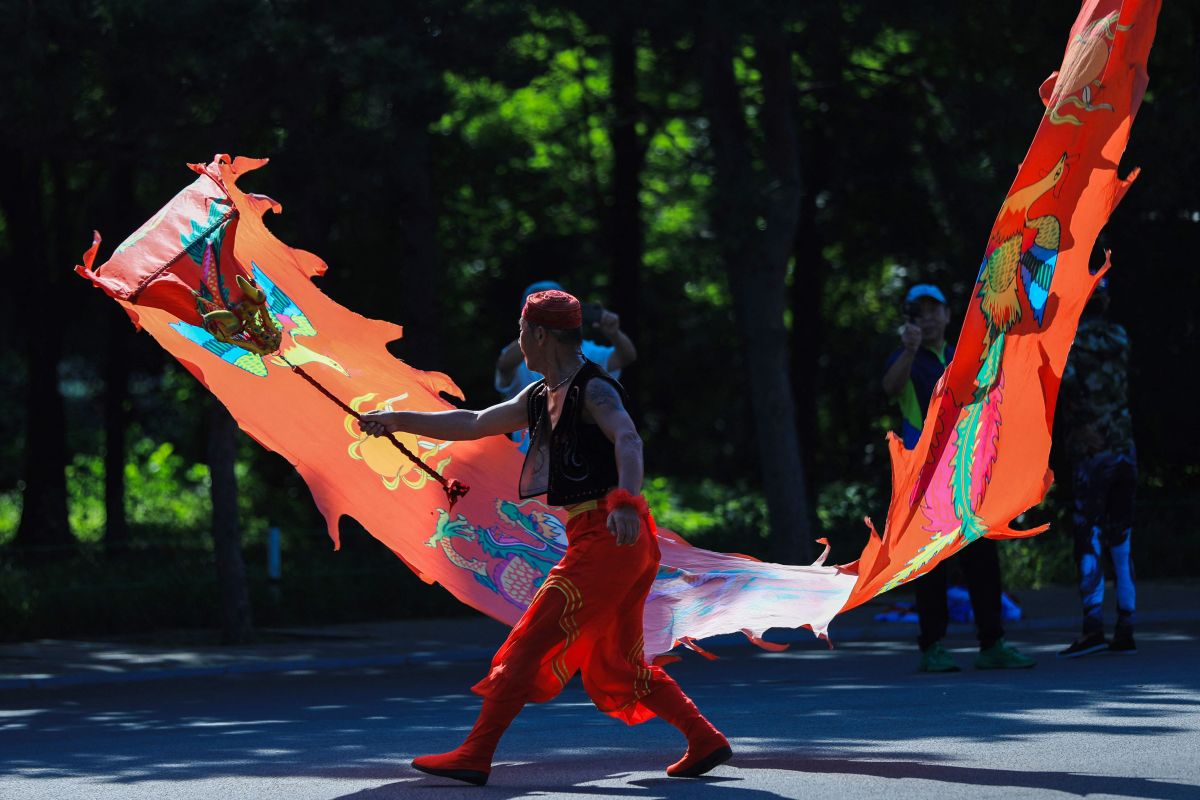If we all waited until we were in our very best moods in order to exercise, our Strava feeds would be pretty empty and our gym memberships pretty useless. Working out means working with whatever emotion is ruling your day, week or year. If you want to string together a consistent fitness regimen — and ideally, an exercising life — you’ll have to ride the positive moods and weather the unsavory ones, alike.
It’s totally understandable, though, that this gung-ho ethos turns a lot of people away from working out. So, consider this: you don’t have to hammer the same form of exercise, no matter how you feel. Different moods can actually function as CTAs to try different forms of exercise. Whether you’re sad, motivated…even hungover, lean into it. Meet yourself where you are. Auto-regulate with a medium that meets the moment.
From anger and boxing to loneliness and team sports, we’ve paired 10 moods with 10 forms of exercise below. Some of these moods may only impact you for an afternoon; others may be a bit of a “theme” for you throughout your life. Mix and match accordingly. You don’t have to be in a good mood to move. But it’ll probably put you in one anyway.
A Guide to the Best Life Hacks From the Last 100 Years
Miracle mornings, presidential matrixes and more. These approaches can actually change your life.Sad: Yin Yoga
The traditional, vinyasa-inspired yoga that most of us are familiar with is “yang yoga,” which is all about building heat in the body and strength in the muscles, through rhythmic sequences. It’s an excellent exercise practice, but as anyone who’s signed up for a 60-minute class knows well, this sort of yoga usually isn’t as easy as you’d think.
And if you’re feeling sad, sometimes easy exercise is precisely what you need. Not so you can magically make yourself happy, but so you can gently validate whatever tough week or long-term grief you’re grappling with, in a low-stakes arena, with movements that remind you you’re worth taking care of. Yin Yoga champions simple poses (butterfly, shoelace, child’s, dragon) and slow-paced holds (up to five minutes at a time). Focusing on depth and breath — and appreciating the enterprise’s passivity — offers you a chance to process your emotions, or, perhaps, just leave them alone.
Look to stretch your deeper connective tissues and coax some flexibility out of your ligaments, tendons and fascia. If it’s starting to hurt, ease yourself into savasana (the corpse pose). It may not look or feel like conventional exercise (if even conventional yoga), but it all counts. You don’t “have” to get to the gym or keep a run streak going or do anything that you’re privately sure will dig you into a deeper hole. On a different day, when you’re in a different mood, you can gear up for something else.
Angry: Boxing
Pretty self-explanatory. When you’re pissed off, hitting something feels good. Better to put on wraps and 12-ounce gloves than send a crazy email or get behind the wheel. Studies have confirmed that non-contact boxing (i.e. throwing punches, not sparring with a partner) “provides a cathartic release of anger and stress, with evidence of improved mood, self-esteem, confidence, concentration, metabolic burden, strength and coordination.”
It’s true that in many self-defense martial arts, like Tae Kwon Do, or Aikido, or Shaolin Kung Fu, it’s critical that you learn to harness your anger and deploy it accordingly. And in boxing, too, you don’t want to start whaling on something so hard that your burn through your energy or hurt your wrist.
But boxing drills tend to reward gut-driven, fast-paced, old-fashioned aggression. The activity converts anger units to good use, propelling you through challenging combos and lefty lead hooks. There’s catharsis in every punch — if you haven’t hit a bag in a minute, watch how long it takes before you start letting out some verbal steam, too. An added bonus: it’s hard to be angry when you’re tired. After a long session, you’ll find yourself in a puddle of exhaustion and endorphins.
Bored: Circuit Training
Quick disclaimer: in general, there is nothing wrong with boredom. As mental states go, it gets an unfair rap, and if anything, we should be actively seeking out more “boredom” in our lives. Recent psychological research illustrates that empty afternoons should not be seen as non-productive. (One of our favorite quotes on this concept: “Creative people need time to sit around and do nothing.” )
That said, if you’re in a constant state of boredom with your fitness regimen, that initial mood can easily breed apathy, which is a tough long-term attitude to shake. If cognitive fitness benefits from sitting around, just staring at the ceiling, physical fitness subsists on you getting up and doing something.
It helps to have a format that a) won’t overwhelm at the outset, yet b) allows you to try different modes of exercise, in order to keep things fresh. We love the 20-minute HIIT circuit workout here, which you can populate with any manner of moves: jump rope, stair runs, box jumps, calisthenics. Circuits are a lot of things (full-body, heart-pumping, sometimes puke-worthy) but they’re never boring.
Lonely: Intramural Sports
More than a mood, loneliness is now a full-blown health epidemic. Over half of American adults report feeling lonely, and lonely people are more likely to experience the negative emotions in this list: anger, stress, sadness. Even the age group that seems most connected between school and social media, young adults, is awfully lonely: according to a recent CDC survey, 63% of the demographic is suffering from loneliness.
Based on how wellness podcasters talk about exercise, it might start to seem like loneliness is a self-inflicted condition, and your only way out of it is to make exercise a cornerstone of your life. Fitness influencers extoll the merits of shooting for the 1,000-pound club, or signing up for a half-marathon. And fair enough — both are lofty, worthy goals that will likely tie you to a larger community, perhaps linking you with specific mentors or peers.
But loneliness is stressful enough on your heart. First and foremost, you should treat this mood with camaraderie, not cardio. We recommend getting a team together. Or joining a team through a local league’s free agent waivers. Play soccer, sign up for softball, start bowling. Anything. It doesn’t matter if you aren’t a sports person. It doesn’t matter if you suck. The rhythm of intramurals guarantees a night a week you have somewhere to be. You’ll move your body, which is great, but you’ll get some laughs in, too. And that’s just as important for your health in the long run.
Happy: Freestyle
Happiness is the simplest, yet most subjective of the moods. You know it when you see it, and only you know if a form of exercise is going to further fuel it or stop it in its tracks.
In an ideal world, we would all associate exercise with happiness. We would all appreciate that even taking “exercise snacks” here and there can supercharge our mood and brighten our days. But lots of us — for lots of different reasons — have difficult relationships with movement, thinking of it as something between a chore and a sufferfest.
So, here’s a resolution: on those days you’re happy, do whatever exercise makes you happy. Freestyle it. It’s a smart way to “bundle” whatever that activity is, with the single best mood that there is. Some examples? Walking through the park. Longboarding. Gardening. Shooting hoops. Let exercise in on your good mood. Give it the chance to make it even better.
How to Increase Your “Neuroplasticity,” in 7 Key Steps
You have the power to change your brain. This guide will help you get going.Motivated: Long-Distance Running
We recently wrote about long-distance running’s impact on kindness, how it helps cultivate patience, gratitude and perspective over years and years of lacing up one’s sneakers. It’s a special thing. But that sweet sentiment doesn’t make the initial prospect of running any less daunting — you still have to stay on your feet, out in the elements, for up to hours at a time, with nourishment many miles away.
It’s a nightmare scenario for anyone who wants a quick wellness fix. But it’s tremendously rewarding for anyone motivated to do it. If you’re motivated in the short-term (say: the weather’s great, you’re feeling fresh and want to burn some calories), it’ll better your day. If you’re motivated in the long-term (you want to change your life), it’ll slowly but surely push all of your biomarkers in the right direction, like a big truck executing a K-turn.
We’ll award honorable mentions here to other Zone 2-associated activities like cycling, swimming and cross-country skiing, which also pair well with motivated individuals. That said, they’re each a little less turn-key, and require extra equipment or commitments. (If you go the distance on those activities, though, that’s proof of how motivated you were at the start.)
Restless: Rock Climbing
Not reckless, but restless, though we’ll admit there’s some overlap here. Restlessness generally boils down to a surplus of energy, an urge to move, a need to get out and try something and tinker.
It’s a unique desire amongst these moods, in that movement is such an obvious initial prescription. The type of movement is relevant, though — a restless person has likely tried running, or lifting, or joining a team before. So this is where action sports have a real chance to shine.
Rock climbing, or bouldering, is one of the best activities for restlessness (and now increasingly accessible in big cities, where schist cliffs aren’t too easy to come by). It’s effective for the perennially-restless types, those erstwhile-twitchy toddlers. You have to use your body and your brain in order to finish a route; it’s essentially a calorie-sapping vertical escape room. But it’s also a great idea for anyone who’s in between fitness regimens, who finds themself in low supply of both physical strength and neuroplasticity.
Hungover: Nature Walk
By and large, there are three reasons people decide to exercise the day they’re nursing a hangover: they want to cure it, they want to continue some sort of fitness streak, or they just want to feel better about themselves. All fair. But science tells us that only the third reason holds any weight — and even then, exercising with any sort of intensity can prove self-defeating.
Consider: while “sweat it out” is a common colloquialism, it’s misrepresentative of how the body eliminates alcohol. You can’t go for a cycle and expect Casamigos droplets to spring from your forehead, like those old Gatorade commercials. Some of the alcohol is broken down into toxins that leave the body through your breath and sweat (which is why you might go around smelling like tequila the morning after), but the majority is expelled as urine.
If you’re hungover, pencil in a “rest-day workout,” which in this case, we’ll define as a walk somewhere nice. You shouldn’t be bench pressing when your brain’s frantically sending water around the body and protein synthesis is all but shut down in your muscles. A stroll will get you out of the house, giving you a chance to call a friend, get a head start on your hangxiety, or just take some much-needed time to yourself. Look at the trees, sit on a bench, take it all in. Then go home and go to sleep. You’ve earned it.
Relaxed: Tai Chi
This isn’t to say you can’t perform Tai Chi when you’re not relaxed. You can — and should — perform Tai Chi whenever you want. But the ancient practice, with the nickname “meditation in motion,” pairs real well with a light touch and an open mind. It’s the sort of thing you shouldn’t try to cram into a 10-minute span between walking the dogs and hopping on a Zoom.
The activity’s 108 moves are all practiced in a fluid, sequential state and accompanied by circular breathing (inhale through the nose, exhale through the lips — long, slow and over and over again). Some trainees like to listen to guided voiceovers as they perform it, or radio programs, or Beethoven. It’s all about moving slowly, purposefully and mastering energy transfer. If you come in loose and relaxed, you’re more likely to find the flow state…and keep coming back for more.
It might sound like a lot of mumbo jumbo. Fine — relaxed people love mumbo jumbo. But Tai Chi uses practically every muscle in the body. It has a positive impact on strength and bone density, and carries real aerobic oomph, too; men who take up Tai Chi were as likely to lower their risk of death as counterparts who adopted jogging. This correlation goes stronger the longer you go. If you give your relaxed self 20 minutes of Tai Chi a day, you’re sitting pretty well into old age.
Stressed: Deep Breathing
This one’s for all of us. This is the final boss of moods, the one none of us can ever avoid for long. And yet, it also comes with the least typical exercise pairing.
Breath is the only autonomic operation in the body that we can actively control. That’s nuts — of all the passive processes your brain is powering throughout your body, breath is the single one you can actually influence, whenever the heck you want. And doing so can have a literal, tangible impact on your mood, by immediately lowering your heart rate and blood pressure.
Which is why it’s so important to elevate breathing “techniques” to “exercise status” in your brain. These can be dedicated sessions, where you’re sitting down and using something like diaphragmatic breathing to calm your entire body. (The South Koreans do something similar to this, called “hitting mung.”) Or it can mean plugging in breaths at your desk, throughout your work day, to avoid falling into screen apnea. Find our full guide to the best breathing exercises here.
Whether you’re looking to get into shape, or just get out of a funk, The Charge has got you covered. Sign up for our new wellness newsletter today.


























